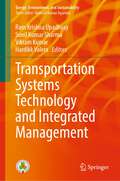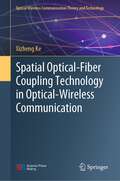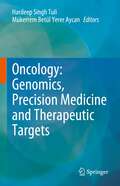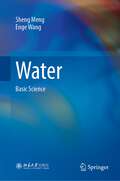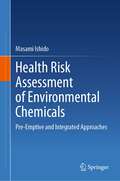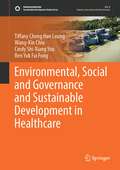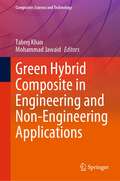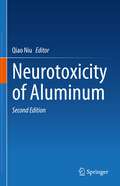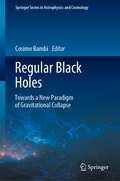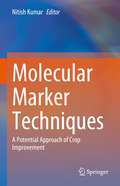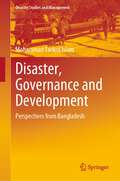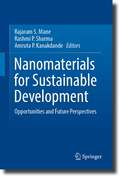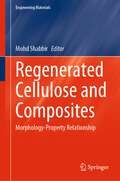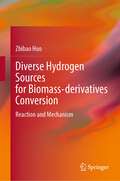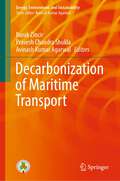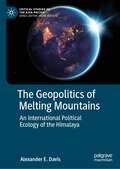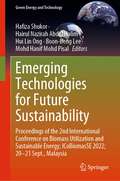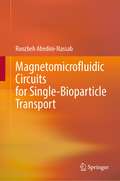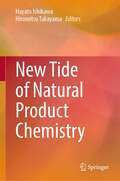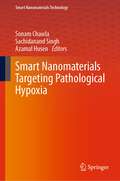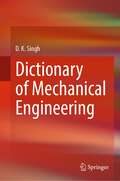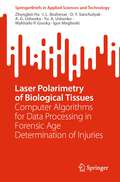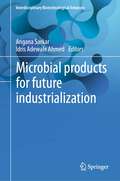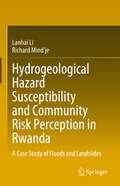- Table View
- List View
Transportation Systems Technology and Integrated Management (Energy, Environment, and Sustainability)
by Ram Krishna Upadhyay Sunil Kumar Sharma Vikram Kumar Hardikk ValeraThe book highlights the transportation ecosystems and its management with underlying technologies for futuristic freight and passenger movement. The contents include contributions on climate change impact on transportation infrastructure, enhancing multimodal transportation, solar energy in railways, managing public transportation with technology, among others. It also includes chapters of newly developed technologies for the intelligent transport system. This book is a useful guide to those working in academia and industry in transportation technology.
Spatial Optical-Fiber Coupling Technology in Optical-Wireless Communication (Optical Wireless Communication Theory and Technology)
by Xizheng KeThis book analyzes the development of space light-fiber coupling research, highlights its importance, examines the underlying theory and key problems, and elaborates on methods to improve the space light-fiber coupling efficiency. Starting from the basic theory of electromagnetic field, the transmission characteristics of light in optical fibers are expounded, and the coupling characteristics of optical signals of different modes are investigated. The spatial light-fiber coupling techniques such as mode conversion method, lens coupling method, and wavefront distortion correction method are discussed in detail, and the key technologies involved are verified by experiments. This book is suitable for the vast majority of engineering and technical personnel and teachers in colleges and institutions who are engaged in wireless optical communication. It can also be used to train senior undergraduates and graduate students in relevant fields.
Oncology: Genomics, Precision Medicine and Therapeutic Targets
by Hardeep Singh Tuli Mükerrem Betül Yerer AycanThis book describes translational cancer therapeutics and the way forward from clinical and molecular diagnosis to treatment. In addition, genomics alterations, microRNAs, and long non-coding RNAs translate precision medicine for the individualistic therapy of cancer patients. It describes the involvement of various pharmacogenetic factors in pharmacodynamic/pharmacokinetic (PD/PK) modulations of medicines. Indeed, the role of bioinformatics and biostatistics, considering the extensive data analysis serving precision medicine approaches, has also been entertained in the present book. Therefore, intended book demonstrates the successful medical evidence for the use of precision medicine in the treatment of cancer and its future clinical perspectives. It fills the gaps in cancer biology and precision medicine with its up-to-date content and well-designed chapters. It will serve as a valuable resource for science, medical students, and interdisciplinary researchers. It is a very welcome addition for the scientific community, research centers, and university-industry research collaborators to find out a complete capsular package about cancer drug targets, precision, and personalized medicine (including an introduction to cancer cell signaling, genomic alterations, miRNA targeting, pharmacogenetics, biomarkers, and metabolomics in precision medicine, etc.) at a single platform.
Water: Basic Science
by Sheng Meng Enge WangThis book highlights the fundamentals for understanding the essential problems and latest progresses in basic water science. Water is the most abundant, fundamental and important matter in nature. Arguably it is also the material that human beings study the most but misunderstand the most. Compared with the environmental science and engineering research activities on water resources, water pollution and water usage closely related to social problems at the macro level, basic scientific research on water at the molecular level has just emerged, the impact of which is not fully recognized yet. This book is devoted to introducing some important advances in the field of basic water science in past decades, with a particular emphasis on recent results on water and the interactions between water and solid surfaces at the molecular level. Starting from introducing concepts and popular theoretical and experimental methods for basic water research, this book mainly focuses on the atomic composition, electronic structure, and physicochemical properties of water molecules, water clusters and water layers (including surface water layers and water surface layers), rules for water adsorption on metals, oxides, and other typical solid surfaces such as salt, as well as the microscopic processes and mechanisms of water diffusion, wetting, decomposition and phase transformations under a variety of conditions. It is a good reference book for students and researchers in water-related science.
Health Risk Assessment of Environmental Chemicals: Pre-Emptive and Integrated Approaches
by Masami IshidoThis book presents the frontier research of toxicology and health risk assessment of chemicals. First, it provides an overview of the current methods of evaluating safety amounts of chemicals and provides a new aspect of the principle of toxicology. Secondly, it shows recent research where the new method of health risk evaluation is adopted, followed by an integrated health risk assessment of chemicals. Finally, it describes the epigenetic inheritance of chemical impact on health throughout several generations. Estimating the safety amount of chemicals surrounding our lives is not sufficient for health risk evaluation, particularly for carcinogenic compounds, endocrine disruptors, and nano materials. The author’s group has found a family of chemicals linked to ADHD through animal screening and identified its chemical nature using chemoinformatics methods. Based on these new developments, this book proposes to utilize the biomarker common to those chemicals for health risk assessment, independent of exposure routes and physiological dimensions. The book appeals to researchers and students in the field of toxicology, health risk assessment, pharmacology, and public health.
Environmental, Social and Governance and Sustainable Development in Healthcare (Sustainable Development Goals Series)
by Tiffany Cheng Leung Wang-Kin Chiu Cindy Shi-Xiang You Ben Yuk FongThis book applies environmental, social and governance (ESG) to issues of sustainable development in healthcare. ESG reporting has been widely used for some time in the business industry to show the economic, social and environmental responsibilities of companies that aim to achieve superior ESG performance for lower risk, more accountability and transparency. Moreover, public-listed companies in healthcare have been growing in significant numbers in recent years. The application or practice of ESG in healthcare has become a growing trend for these large organisations looking to demonstrate their strengths in areas of financing, operations, sustainability and social responsibilities. Such an approach is essential not only for the long-term development of the companies but also for services delivered by healthcare practitioners. Equally, the implications to Sustainable Development Goal (SDG) 3 is relevant to healthcare worldwide with a growing ageing population, which has led to a great burden of care in many countries, particularly in the public sector. The potential development and expansion in private healthcare services, accelerated by technology advancement, has demanded a new paradigm in the healthcare industry, particularly in business, service delivery and policy. The book examines this paradigm through health in all policies, ESG and SDG 3 objectives, research, training and practice. It is relevant to graduate students and scholars working in areas relating to health, business and the SDGs and is also useful to policymakers and practitioners in healthcare.
Proceedings of the 4th International Symposium on Plasma and Energy Conversion: ISPEC 2022, 14-16 Oct, Foshan, China (Springer Proceedings in Physics #391)
by Dong Dai Cheng Zhang Zhi Fang Xinpei LuThese proceedings highlight the fundamental researches and up-to-data developments on energy conversion and high-voltage application by means of low temperature and atmospheric pressure plasma. In recent years, plasma-assisted energy conversion gains increasing attention as an alternative to thermal-catalysis or electro-catalysis. These proceedings discuss and exchange cutting-edge scientific innovations and technological advances in fields like plasma-enabled synthesis of chemicals and fuels, plasma-enabled the environmental clean-up, plasma-enabled catalysis treatment, in-situ probing of plasma-catalyst interactions and its high-voltage applications, which show great potentials in industrial demands like CO2 hydrogenation, CH4 reforming and nitrogen fixation, plasma deposition, chemical synthesis, VOC abatement and high-voltage insulation.This collection of papers presents the main applications of plasma-induced energy conversion and high-voltage discharge in the form of separate chapters, including cutting-edge studies on conversion technology, complex mechanism simulation, in-situ detection and converged applications by artificial intelligence. These proceedings are suitable for researchers engaged in fields like plasma-catalysis, discharge diagnosis and modelling, chemical modelling and high-voltage applications.The major topics covered in the conference proceedings are:1) Advanced plasma-catalysis conversion technology;2) Advanced in-situ discharge diagnosis technology;3) Advanced in-situ plasma-catalysis characterization;4) Multi-scale or innovative modelling technology;5) High-voltage discharge and application.
Green Hybrid Composite in Engineering and Non-Engineering Applications (Composites Science and Technology)
by Tabrej Khan Mohammad JawaidThis book introduces the different advanced hybrid composite materials used in aerospace, automotive, marine, and general engineering infrastructures. It represents the current development processes and applications in aircraft, automobile, and marine structures. This book also contains test cases and their validation using a finite element approach using computer tools. The book also deals with the design approach for innovative hybrid composite materials focused on diverse engineering and non-engineering applications. A detailed review of the state-of-the-art composite materials study presented here would be of interest to scientists, academics, students, and engineers and professionals in general working in the field of advanced composite materials and structures. This book is also useful for Ph.D. research scholars to improve their fundamental understanding of advanced materials and is also suitable for master’s and undergraduate courses on composite materials.
Neurotoxicity of Aluminum
by Qiao NiuThis book reviews the scientific literature and the authors’ own research linking aluminum neurotoxicity with cognitive impairment and Alzheimer’s disease (AD). It focuses on aluminum levels in the brain, region-specific and subcellular distribution, its relation to neurofibrillary tangles and amyloid beta—the pathological features of AD, and the possible mechanism of aluminum inducing these pathological features. Further, the book stresses the importance of aluminum’s complex speciation chemistry in relation to biology, and details aluminum’s mechanism in oxidative stress and cell death, especially in connection with apoptosis and necroptosis. The electrophysiological variation and synaptic plasticity induced by aluminum are covered, while the metal’s debatable role in AD and the cross-talk between aluminum and genetic susceptibility are also discussed, and more recently the relationship between aluminum-induced epigenetic modification on DNA and non-coding RNAs and neuron death and synaptic impairment.The second edition updates eight chapters according to the most recent researches. Content about aluminum-induced AD-like pathological features, neurotoxic effects of aluminum and aluminum alloy nanoparticles(TBD) and alumina nanoparticles induced neurotoxic and neurodevelopmental toxic effects is also added. In closing, this book provides readers with a systematic summary of aluminum neurotoxicity.
Regular Black Holes: Towards a New Paradigm of Gravitational Collapse (Springer Series in Astrophysics and Cosmology)
by Cosimo BambiBlack holes are one of the most fascinating predictions of general relativity. They are the natural product of the complete gravitational collapse of matter and today we have a body of observational evidence supporting the existence of black holes in the Universe. However, general relativity predicts that at the center of black holes there are spacetime singularities, where predictability is lost and standard physics breaks down. It is widely believed that spacetime singularities are a symptom of the limitations of general relativity and must be solved within a theory of quantum gravity. Since we do not have yet any mature and reliable candidate for a quantum gravity theory, researchers have studied toy-models of singularity-free black holes and of singularity-free gravitational collapses in order to explore possible implications of the yet unknown theory of quantum gravity. This book reviews all main models of regular black holes and non-singular gravitational collapses proposed in the literature, and discuss the theoretical and observational implications of these scenarios.
Molecular Marker Techniques: A Potential Approach of Crop Improvement
by Nitish KumarThis edited book covers the applications of molecular markers in the genetic improvement of crop plants. Recent advances in molecular marker techniques such as the development of high-throughput genotyping platforms, marker-assisted selection, and non-coding RNA-based markers have been discussed. Essential information is provided on functional markers, genotype-by-sequencing, and association mapping methodologies that can facilitate accelerated crop breeding programs for increased yield, high nutritional quality, and tolerance to a variety of abiotic and biotic stresses. This volume presents basic information on molecular marker techniques from marker location up to gene cloning. The book includes a description of technical approaches in genome analysis such as comparison of marker systems, positional cloning, and array techniques. This book is of interest to teachers, researchers, and plant breeders. The book also serves as additional reading material for undergraduate and graduate students of agriculture, horticulture, and forestry.
Disaster, Governance and Development: Perspectives from Bangladesh (Disaster Studies and Management)
by Mohammad Tarikul IslamThis book unveils the nexus between disaster, governance and development with a particular focus on Bangladesh and examines the legislative and institutional aspects in mainstreaming disaster risk reduction into development planning. With the help of rich content analysis interpreting disaster management history of the country, it looks at the challenges associated with disaster management in the context of Bangladesh. The book highlights the most reasonable strategy on how to accelerate a paradigm shift from relief culture to DRR culture. It also assesses the viewpoint of how political economy influences governance and institutional strengthening, thus identifying obstructions and opportunities for mainstreaming disaster management into development. The book also lays emphasis on collaboration between public sector and private sector for the expansion of disaster risk reduction programme. It shows how multilevel governance works for professionalizing disaster management and throws light on policy frameworks developed. This book is a tremendous resource for scholars, practitioners and researchers of disaster management, environmental studies, development agencies, political science, public policy, development studies, governance, regional development, South Asian studies and local government, particularly those interested in disaster, governance and sustainable development.
Nanomaterials for Sustainable Development: Opportunities and Future Perspectives
by Rajaram S. Mane Rashmi P. Sharma Amruta P. KanakdandeThis book highlights recent advances in variety of nanomaterials classes including metal chalcogenides, metal oxides/hydroxides, polymer, metal-organic frameworks, and hybrid nanostructures, with a focus on their properties, synthesis methods, and key applications. It also offers detailed coverage on the toxicity aspects with possible solution. Additionally, it provides complete and comprehensive information on surface modification strategies of nanoparticles to achieve desired outcomes. This book discusses potential applications and major challenges of using these nanomaterials in the fields of biomedical sciences, agricultural industry, bioenergy, biofuel production, and environmental remediation, etc. Overall, this book provides crucial background in nanobiotechnology that compliments the understanding of experimental design for the production of more customized nanomaterials to avail desirable benefits.
Regenerated Cellulose and Composites: Morphology-Property Relationship (Engineering Materials)
by Mohd ShabbirThis book highlights the morphology-property relationship of regenerated cellulose materials and composites, as morphology of materials is the key feature and corresponds to associated applications of/to the materials. It is highly essential to assimilate the literature on morphology-property relationship of cellulose materials. Being the most abundant natural polymer on earth and gateway to large number of applications, cellulose is expected to be researched for higher efficiencies. Various books and research articles have targeted the specific morphologies, the respective characteristics and application areas. This book presents literature on morphology-property relationship of cellulose materials and provides a direction to this relationship.
Diverse Hydrogen Sources for Biomass-derivatives Conversion: Reaction and Mechanism
by Zhibao HuoThe book covers advances in conversion of biomass and derivatives into useful chemicals and fuels. It describes our recent researches relating to the hydrogenation of biomass derivatives by diverse hydrogen sources such as water, isopropanol, gaseous hydrogen and NaBH4 as well as their interesting mechanism aspects. A wide range of biomass derivatives and some novel hydrogenation processes are involved in this book. Development strategies and challenges in future research are also discussed. This book will help readers to expand their knowledge of biomass and its derivatives conversion.
Decarbonization of Maritime Transport (Energy, Environment, and Sustainability)
by Burak Zincir Pravesh Chandra Shukla Avinash Kumar AgarwalThis contributed book focuses on decarbonization of maritime transport by highlighting different aspects of decarbonization methods indicated in the International Maritime Organization’s Initial Greenhouse Gas Strategy (2018). The book contains studies on alternative fuels and alternative energy systems with their life cycle assessment, electrification and hybridization of ships, carbon capture technologies, green port concept, energy efficiency management, and market-based measures. This book will be of interest to those working in academia and industry in maritime technologies and transportation.
The Geopolitics of Melting Mountains: An International Political Ecology of the Himalaya (Critical Studies of the Asia-Pacific)
by Alexander E. DavisThe book addresses the urgent need for rethinking the geopolitics and ecology in the Himalaya, by emphasising the entanglements between these two factors. Most international relations analyses of the Himalaya emphasize the central role of the region’s states and their great power struggles. By reducing the region to its state actors, however, we miss the intense more-than-human diversity of the region, and the crucial role that the mountains play in the global environment. In doing so, the book makes a major contribution to international relations theory by drawing on insights from international political ecology. It first theorises international political ecology and examines the Himalaya as a global region, before moving looking at the international aspects of political ecology in the Himalaya through key areas of the mountains where international politics and ecology are deeply, inextricably linked. It presents three detailed case studies of different environmental and political issues in the Himalaya: icecaps (the India-China-Pakistan boundary dispute in the western Himalaya), foothills and forests (the Nepal-Bhutan-Sikkim borderlands), and rivers (the India-China Bangladesh dispute over the Brahmaputra River basin). Each case study draws on a mix of source materials including fieldwork, government sources, foreign policy discourse, Himalayan ethnographies, and environmental and ecological sciences scholarship.
Emerging Technologies for Future Sustainability: Proceedings of the 2nd International Conference on Biomass Utilization and Sustainable Energy; ICoBiomasSE 2022; 20–21 Sept., Malaysia (Green Energy and Technology)
by Hafiza Shukor Hairul Nazirah Abdul Halim Hui Lin Ong Boon-Beng Lee Mohd Hanif Mohd PisalThis book presents high-quality peer-reviewed articles from the 2nd International Conference on Biomass Utilization and Sustainable Energy 2022 (ICoBiomasSE 2022) organized by the Centre of Excellence for Biomass Utilization (COEBU), Universiti Malaysia Perlis (UniMAP), Malaysia. The theme of the conference “Emerging Technology for Future Sustainability” is chosen in view of the current revolution and rapid developments in the field of biomass innovation towards sustainable development. The contents are broadly divided into five parts: (1) sustainable biomass resources for decarbonizing the economy, (2) biomass conversion technologies for bioenergy and biofuels, (3) biomass conversion to intermediates and products, (4) bioeconomy sustainability, impacts and policies and (5) bioenergy integration. It provides a platform for students, professionals, researchers, academicians, policymakers and industries working in the areas of biomass utilization and sustainable energy to solve long-standing environmental issues for a healthier planet.
Magnetomicrofluidic Circuits for Single-Bioparticle Transport
by Roozbeh Abedini-NassabThis book highlights the current state of the art in magnetophoretic circuits and their use in the emerging field of single-cell analysis. This interdisciplinary topic involves many fields of science including cellular biology, drug screening, cancer research, personalized medicine, microfabrication, biomedical microdevices, and lab-on-a-chip. This book not only provides the required fundamental knowledge and background needed in magnetics and the circuit theory but also describes the idea of magnetophoretic circuits as well as the cutting-edge developed technologies. It provides a sufficient background in i) the required theory in magnetics, ii) SCAs in general, iii) the circuit theory, iv) the developed idea of the magnetophoretic circuits, v) the fabrication process and magnetic cell labeling techniques, vi) the magnetophoretic-based SCA tools, and vii) the bio-applications. Methods for performing simulations as well as designing, fabricating, and running experiments are explained. Author of the book is one of the inventors of some of the ideas and the author/co-author of some of the related articles in high-impact journals. The book appeals to the readers interested in clinical applications as well as the ones interested in its technical aspects. It is beneficial for researchers interested in the field of single-cell analysis from various disciplines including biomedical engineering, mechanical engineering, electrical engineering, materials science, and cellular biology.
New Tide of Natural Product Chemistry
by Hayato Ishikawa Hiromitsu TakayamaThis book highlights recent research and advances in natural product chemistry written by promising young researchers in this field who have played a central role for recent innovative advancements. The book consists of seventeen chapters covering novel bioactive natural products, uncovering life phenomena with natural products, biosynthesis of natural products, total synthesis of complex natural products by innovative strategies, and drug discovery using natural products. Each chapter begins with a brief and easy-to-understand introduction, then presents the cutting-edge research in each individual specialty. This book is not only a practical and essential reference resource for natural product chemists, medicinal chemists, synthetic organic chemists, biochemists, pharmacologists, as well as the pharmaceutical and biotechnological industries, but is also a useful guide to understanding new and emerging trends in this field.
Smart Nanomaterials Targeting Pathological Hypoxia (Smart Nanomaterials Technology)
by Azamal Husen Sachidanand Singh Sonam ChawlaThe book showcases the newest research on smart nanoplatforms responding to “hypoxia”; an omnipresent pathological feature of many modern-day diseases and its potential applications. The book demonstrates the versatility of hypoxia targeted smart nanoplatforms in disease management in diverse pathological settings presented in chapters contributed by various experts in the field. The themes in the book touch upon critical facets to address pathological hypoxia such as nanomaterials enhancing oxygenation, hypoxia responsive nanoformulations which deliver the drug directly to the hypoxic site, limited toxicity and enhanced efficacy of smart nanoformulations to counter molecular consequences of hypoxia, and theranostics combining hypoxia detection systems with drug delivery systems. This book disseminates the current implications of smart nanomaterials in disease management that can be exploited by scholars, researchers, and pharma industries to develop, manufacture, and commercialize hypoxia targeted diagnostics and therapeutics.
Dictionary of Mechanical Engineering
by D. K. SinghThis book contains important words and terminologies of the core subjects in mechanical engineering such as engineering mechanics, strength of materials, fluid mechanics, thermodynamics, IC engines, heat and mass transfer, refrigeration and air-conditioning, manufacturing processes, theory of machines, industrial engineering and management, electric vehicles, etc. that are explained in a concise and lucid manner. The contents also touch upon some terminologies of basic science subjects. This dictionary is an easy-to-use and a practical resource which will be highly useful for undergraduate and postgraduate students, researchers, and industry professionals in the field of mechanical engineering.
Laser Polarimetry of Biological Tissues: Computer Algorithms for Data Processing in Forensic Age Determination of Injuries (SpringerBriefs in Applied Sciences and Technology)
by Zhengbin Hu I.L. Bezhenar O.Y. Vanchulyak A. G. Ushenko Yu. A. Ushenko Mykhailo P. Gorsky Igor MeglinskiThis book highlights the results of numerical computer-aided smart methods as part of a comprehensive statistical, correlated, and fractal analysis of laser polarimetry. It includes a comprehensive approach to differentiation of lifelong or postmortem origin of injuries and determination of their antiquity based on the analysis of statistical and spatiotemporal frequency evolution of photometric, polarization, and phase parameters of laser images of histological sections of the skin of biomannequins. It discusses the relationship between the coordinate distributions of the intensity of laser images from skin tissues of biomannequins and the nature of its damage. It presents the analysis of relationships between changes in the mean and variance of coordinate distributions of azimuths and ellipticity of polarization images of histological skin sections and the time intervals after injury. Complex differentiation of lifelong and postmortem skin injuries of biomannequins and establishment of their time intervals throughout the entire monitoring interval of changes in the mean and variance of coordinate distributions of phase shifts between orthogonal components of the amplitude of laser images of a series of corresponding histological sections are also presented in this book.
Microbial products for future industrialization (Interdisciplinary Biotechnological Advances)
by Angana Sarkar Idris Adewale AhmedThis book “Microbial Products for Future Industrialization” focuses on the exploitation of various advanced microbial and molecular biology technologies and their associated processes, especially the microbial-molecular-chemical nexus, for the future industrialization of emerging new microbial products. The descriptions given in its chapters take the reader through an entire journey of new emerging microbial products from lab to industry and provide new information that has not yet been fully exploited for future industrialization steps. This volume is a great resource for readers seeking a more comprehensive material covering the technical, economic, and societal aspects that impact bioprocessing of microbial products at the industrial level along with biotechnological intervention for better production of microbial products in near future. This book also encompasses advanced and updated information as well as future directions for young researchers and scientists, and academics who are working in the field of microbial product production related to sustainability.
Hydrogeological Hazard Susceptibility and Community Risk Perception in Rwanda: A Case Study of Floods and Landslides
by Lanhai Li Richard Mind’jeThis book employs qualitative and quantitative methods to assess and scrutinize the impacts of climatic, topographic, land use, hydrologic and geologic factors on the hydrogeological disasters particularly flood and landslide in Rwanda. The hydrogeological hazard susceptibility and its spatial distribution is also mapped by integrating geospatial techniques and mathematical modeling approach through remote sensing and Geographical Information System (GIS). On the other hand, questionnaires and interview are used to evaluate the community's perception on the risk of hazards. The results unveiled different zones most susceptible to the incidence of both hazards as well as their main contributing factors. Furthermore, the results revealed that the government is perceived as responsible for all mitigation measures instead of being a shared responsibility, a perception that may also contribute to the increase in susceptibility. Therefore, it is necessary to deliver the extent of disaster-related courses and trainings in both schools (from primary to tertiary level) and local community members, which helps improving the public's awareness, understanding and ability by providing a new perspective toward disaster prevention and reduction. The book provides a reference for interested readers to understand the natural and human geography of Rwanda, the distribution of hydrogeological disasters, and the policy-making of disaster prevention and reduction.
